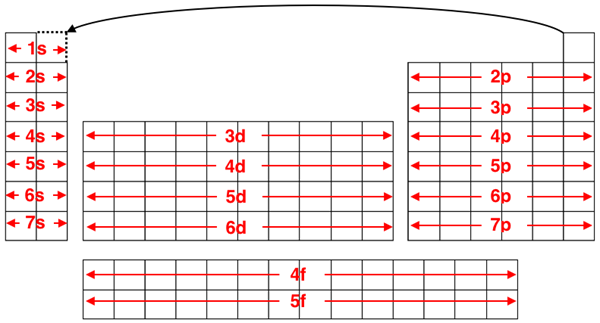Periodic Table Battleship - Help
Each Difficulty Level of Periodic Table Battleship involves the same task - using electron configurations to identify elements to target for a torpedo strike. The end goal is to strike and sink hidden battleships located on the Periodic Table. The Battleships stretch across two or more side-by-side elements. The Difficulty Levels differ in terms of the number of battleships and the regions of the Periodic Table where they are hidden. The table summarizes the difference between Difficulty Levels.
The Battleships stretch across elements in either a horizontal or vertical direction (but never diagonally). And they only stretch across consecutive sie-by-side elements. So you would never see a battleship stretch from magnesium (Mg, atomic number 12) and aluminum (Al, atomic number 13) since they are not positioned next to each other.
The successful completion of a Difficulty Level requires that you target an element using its electron configuration ... or more accurately, using the last part of its electron configuration. If you are unfamiliar with how to write an electron configuration, then we would recommend first surveying our infographic on writing electron configurations (Click here to view infographic.). Doing so will make the task of this Concept Builder more meaningful.
The Periodic Table and Electron Configurations
It ends up that there is a relationship between an element's location on the Periodic Table and the manner in which its electron configuration ends. For instance, the Alkali metal elements - hydrogen (H), lithium (Li), sodium (Na), potassium (K), rubidium (Rb), cesium (Cs), and francium (Fr) - all end with an s1 term. For instance, sodium ends with 3s1 and potassium ends with 4s1 and cesium ends with 6s1. Similarly, the alkaline earth metals - beryllium (Be), magnesium (Mg), calcium (Ca), strontium (Sr), barium (Ba), and radium (Ra) - all end with an s2 term. For instance, magnesium ends with 3s2 and calcium ends with 4s2 and barium ends with 6s2. It is for this reason that these elements - alkali metals and alkaline earth metals - are referred to as the s-block elements. It is worth noting that when it comes to electron configuration, the element helium (He) can be perceived as being out of place. It would be more appropriate if it were placed in the s-block next to hydrogen as its electron configuration is 1s2.
Group 13-18 elements of the Periodic Table are referred to as the p-block elements. Here is the rationale behind such a reference. Electrons fill p-orbitals beginning with the second energy level. There are three p-orbitals in each of these energy levels. Each individual p-orbtial can hold two electrons. Thus, p-orbitals in energy level 2 and higher can hold a total of 6 electrons. Now look at the Periodic Table and notice that there are 6 total elements in every row of Groups 13-18, beginning with the second row. That would be six elements whose electron configurations end with p1, p2, p3, ... p6. Wow! There's a clear correspondence between the location of elements on the periodic table and the orbital type that the last electron in the atom occupies.
Similar reasoning explains why the transition metal elements are referred to as the d-block elements. There are five d-orbitals and each orbital holds at most 10 electrons. Thus there are as many as 10 electrons in d-orbitals for any energy level having d orbitals. The lowest energy level with d orbitals is the 3rd energy level. The first transition metal shows up in the fourth row of the periodic table; yet the highest-energy electrons of those transition metal elements are in 3d orbitals. Thus the four rows of the transition metal elements have their highest energy electrons occupying the 3d, 4d, 5d and 6d orbitals.
And finally, the Lanthanoid and the Actinoid elements represent the f-block elements. There are 14 elements in each of these rows, consistent with the 14 electrons that the f-orbitals can hold. These rows of elements are inserted into the 6th and 7th rows of the Periodic Table between the alkaline earth metals and the transition metals. Even though they are inserted into the 6th and 7th row, the highest energy electrons occupy 4f and 5f orbitals.
The graphic below summarizes these ideas relating an elements position on the Periodic Table and the electron configuration describing the location of the electrons in their atoms.
